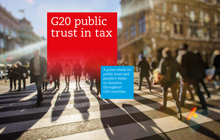Proposed U.S. tax reform could have major impact on Canada

As the Trump administration prepares to release its NAFTA negotiating objectives, proposed U.S. tax reforms looms as an equal threat to Canada
OTTAWA – Businesses in the United States and Canada are keeping a sharp eye on proposed U.S. tax reform plans originating from the White House and from Congress that could seriously impact their operations, as well as their competitiveness.
“It’s very uncertain, but I will say that we have the highest likelihood in the last 30 years of fundamental tax reform happening,” says Russ Crawford, a Vancouver-based partner with KPMG Canada, who is in charge of that firm’s U.S. corporate tax practice in Canada.
At the heart of the proposed reforms are drastically reduced corporate tax rates — as low as 15 per cent if the Trump Administration gets its way or about 20 per cent if the blueprint of the House of Representative Republicans [who hold a majority of the seats] is followed.
Current corporate rates in the U.S. range between 15 per cent and 35 per cent, making the U.S. one of the top tax jurisdictions in the G20 group of countries. Low state effective tax rates can often result from planning, so that a combined federal and state effective tax rate can remain below 40 per cent.
In comparison, Canadian federal corporation tax rates are 15 per cent after the federal tax abatement and the general tax reduction. [The net tax rate for Canadian-controlled private corporations, who are able to claim the small business deduction, is 10.5 per cent]. Add in provincial tax for, say Ontario, and there is a combined corporate tax rate of 26.5 per cent for companies not eligible for the SBD.
With a 15 per cent U.S. rate, “their tax rates would be cheaper than ours, so we will have lost our tax competitiveness right there,” warns Jason Kingston, a principal with the accounting firm DSK LLP in Kitchener.
“If you get to a 15 per cent U.S. tax rate, the Canada/U.S. tax planning world goes topsy-turvy,” says Dennis Metzler, a Toronto-based U.S. tax partner with Deloitte Canada in Toronto. “The traditional objective of shifting profits out of the U.S. and into Canada to reduce the overall effective rate could have the opposite effect,” he adds.
Right now, the U.S. is viewed as a very high rate jurisdiction in which to do business, in spite of there being a variety of incentives and credits which can serve to draw down the overall rate, explains Metzler.
“But in general, many people would say that with a combined U.S. federal and state tax rate that approaches 40 per cent, the U.S. is simply not competitive. We expect that if the U.S. is successful in lowering its corporate tax rate, which is largely viewed as an imperative, that is going to improve the competitiveness of U.S. companies vis-à-vis companies in other jurisdictions,” he elaborates.
No guarantee of U.S. tax reform
But given the current political situation in the U.S. — including the sense by some of the majority of Republicans in Congress that tax reform cannot move forward until they feel they have succeeded on health care reform first — both the timing and the final content of any tax reform package remains very much of an unknown and subject to intense negotiations.
“I’ve been saying all along, ‘I don’t think that we’ll get to 15 per cent,’” says Crawford.
“If you look at what was proposed out of the House Ways and Means Committee, and what’s called the ‘blueprint’ last summer [2016], it talks about going down to a 20 per cent tax rate, and I think any legislation will start off more at that type of benchmark,” he adds.
Reducing the U.S. corporate tax rate to 15 per cent will also be difficult, especially in an era when U.S. budget deficits are high and the U.S. national debt is at record levels. Many congressional Republicans want to see a balanced budget, and deep tax cuts will put a further hole in revenues going to the U.S. treasury.
Crawford notes that the Trump Administration has resurrected old arguments from the Reagan era [1981-89], known as the "trickle down theory of economics" that deep tax cuts will fuel the economy and that, in and of itself, will create more tax revenues.
Another political obstacle is that normally a super-majority of 60 votes in the 100 seat U.S. Senate is required to pass legislation. The Republicans only hold 52 seats, and will need to put a special procedure called ‘Budget Reconciliation’ in place to pass legislation with a simple majority of 51.
“But that then puts in a budgetary restraint that any tax legislation should be neutral over a ten-year period under current procedural rules in the Senate. That, in itself, can put pressure on just how low a rate you can put in, or what other types of tax incentives you could maintain,” says Crawford.
“Therefore I think it will even be very difficult to get to a 20 per cent corporate rate. I’ve been predicting it will be somewhere between 20 per cent and 30 per cent — maybe like 25 per cent,” he concludes.
If the U.S. corporate rate drops to 20 per cent that will still be a significant reduction. However, the impact on Canadian businesses is expected to be much more muted than it would be at 15 per cent.
Tomorrow: the impact of U.S. tax reform on Canadian business. Jeff Buckstein, CPA, CGA, is an Ottawa-based business journalist.








(0) Comments